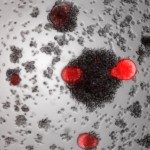Link to Pubmed [PMID] – 26079043
J. Med. Chem. 2015 Jul;58(14):5579-98
Following our discovery of human dihydroorotate dehydrogenase (DHODH) inhibition by 2-(3-alkoxy-1H-pyrazol-1-yl)pyrimidine derivatives as well as 2-(4-benzyl-3-ethoxy-5-methyl-1H-pyrazol-1-yl)-5-methylpyridine, we describe here the syntheses and evaluation of an array of azine-bearing analogues. As in our previous report, the structure-activity study of this series of human DHODH inhibitors was based on a phenotypic assay measuring measles virus replication. Among other inhibitors, this round of syntheses and biological evaluation iteration led to the highly active 5-cyclopropyl-2-(4-(2,6-difluorophenoxy)-3-isopropoxy-5-methyl-1H-pyrazol-1-yl)-3-fluoropyridine. Inhibition of DHODH by this compound was confirmed in an array of in vitro assays, including enzymatic tests and cell-based assays for viral replication and cellular growth. This molecule was found to be more active than the known inhibitors of DHODH, brequinar and teriflunomide, thus opening perspectives for its use as a tool or for the design of an original series of immunosuppressive agent. Moreover, because other series of inhibitors of human DHODH have been found to also affect Plasmodium falciparum DHODH, all the compounds were assayed for their effect on P. falciparum growth. However, the modest in vitro inhibition solely observed for two compounds did not correlate with their inhibition of P. falciparum DHODH.








